Refer to the exhibits.
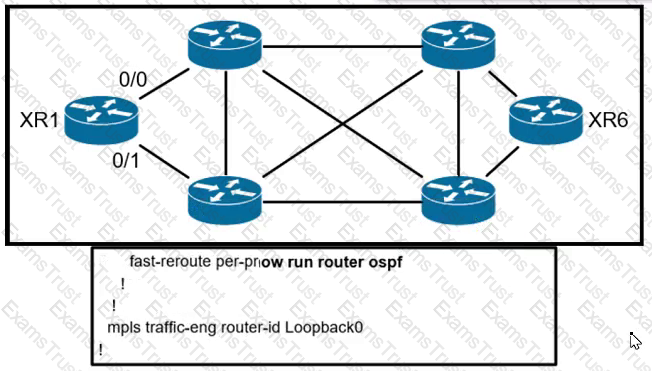
All links inside the network are configured at a default cost of one inside the fully converged OSPF domain. Given the configuration from XR1, which interface does traffic from XR1 that is destined to the loopback interface of XR6 select for the exiting interface?
How does SRv6 function on the control plane?
Which keyword is used with the match route-type command to redistribute the external BGP and IGP routes using route map?
What are two features of dual-stack? (Choose two.)
Refer to the exhibit.
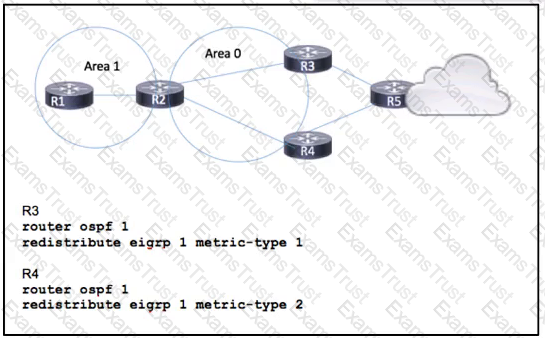
Routers R1, R2. R3, and R4 have been configured to run OSPF. and router R5 is running EIGRP Traffic from R1 to R5 is expected to pass via R4. but OSPF routing has calculated the best path via R3. Which action corrects the problem?
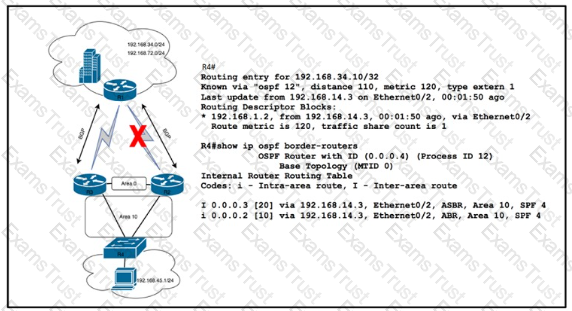
Refer to the exhibit. After a recent network implementation project, customer A is performing stress testing to verify network redundancy at the branch office connected to R4. When the link from R2 is shut öown as shown, the SLA tracking object fails and the cost of the link between R2 and R4 increases to 100. However, a traceroute operation from a PC in the Branch office shows that traffic to HQ is still routed via R2. Which solution corrects the problem and optimizes traffic flow via R3 without creating operational overhead?
Refer to the exhibit.
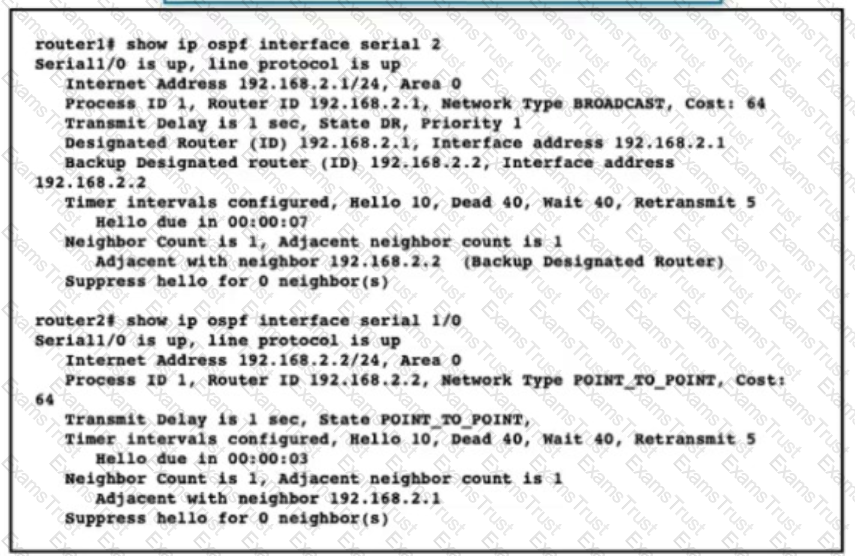
Router 1 and Router2 have shared routes in the OSPF database but the routes are missing from their routing tables. Checking me prefix-list configuration on both routers, the engineer confirmed all networks are allowed What action should the engineer take to fa the problem?
What is a feature of SRGB label values?
Refer to the exhibit.

What is the effect of this configuration?
Drag and drop the features from the left onto the corresponding routing protocols on the right
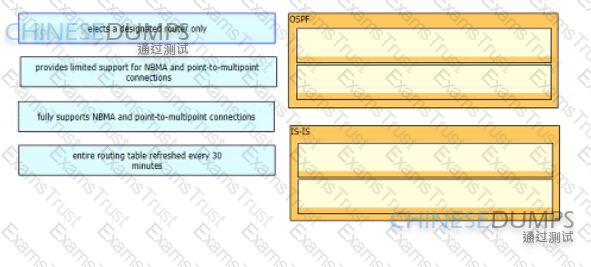
Refer to the exhibit.

Routers within the cluster are not receiving the desired prefixes. What must be done to fix the issue?
Refer to the exhibit.

Which two commands must the engineer configure for the company's PIM-PIM network to enable Auto-RP mappings to be sent over the FastEthernet0/0 interface without affecting normal operation? (Choose two)
Refer to the exhibit.

Which task must you perform on interface g1/0/0 to complete the SSM implementation?

Refer to the exhibit A network engineer installed a new router (router 3) at the regional hub running MPLS services for scalability Router 3 is connected to the 10.44 4.0,'24. 10.44 5.024. 10 44.6.0/24. and 10 44 7 0/24 subnets The new router has been configured for OSPF area 2. and it is advertising the four connected networks. The engineer noticed that the same networks are listed as interarea summary routes, and they are being flooded into each area on the area borders Which action resolves the issue?
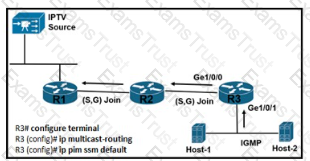
Refer to the exhibit. A network engineer is configuring router R3 to handle multicast streams, but Host-2 cannot send subscriptions messages to the IPTV source. Which configuration must the engineer apply to router R3 so it passes the IPTV stream to Host-2?
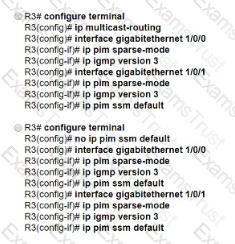
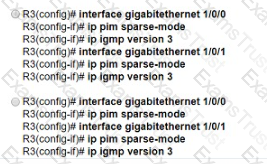
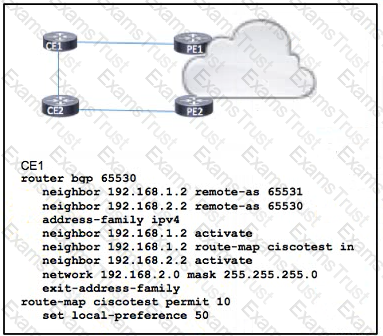
Refer to the exhibit. Routers CE1 and CE2 are in AS 65530. which is multihomed for Internet access. An engineer expects inbound traffic to AS 65530 to arrive from PE1. but it is coming from PE2 instead PE1 and PE2 routers are connected with CE routers through the same bandwidth Which action must be taken to correct the problem?
In a PIM-SM environment, which mechanism determines the traffic that a receiver receives?
Which two characteristics unique to SSM when compared to ASM are true? (Choose two.)
Which two conditions must be met before separate ISPs can provide interdomain multicast routing? (Choose
two.)
Refer to the exhibit.
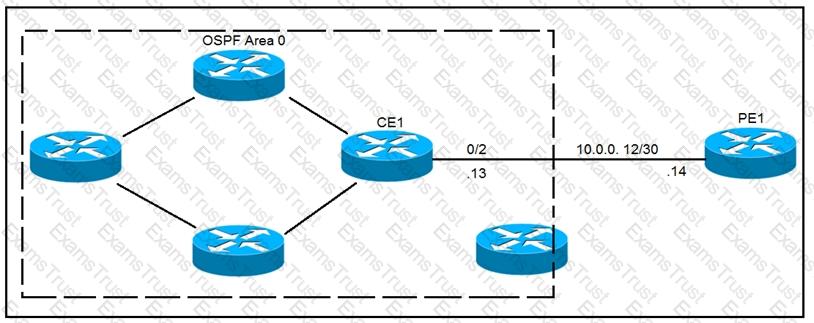
CE1 is the gateway router into the provider network via PE1. A network operator must
inject a default route into OSPF area 0. All devices inside area 0 must be able to reach PE1. Which configuration achieves this goal?
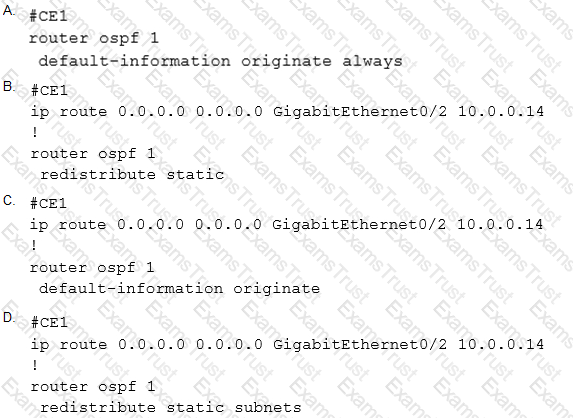
Refer to the exhibit.

A network engineer applied configuration on R1 to summarize all ISIS routes, but R2 Is still receiving specific routes from R1. The engineer has confirmed that both routers are configured with the correct summarization configuration, but R1 is not sending the correct summary routes. Which configuration must be applied to router R1 to summarize routes within Level 1?
Refer to the exhibit.
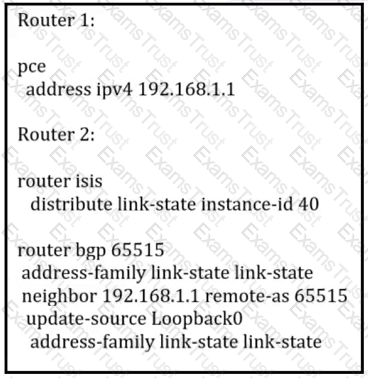
What is the relationship between Router 1 and Router 2?
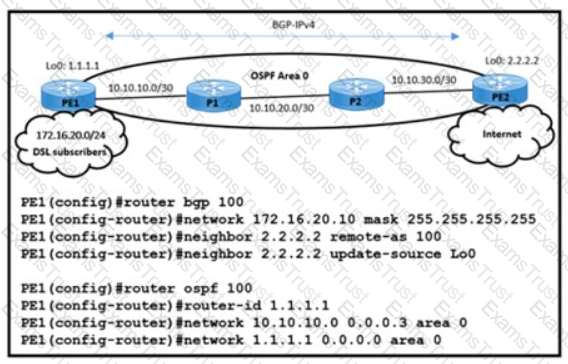
Refer to the exhibit The engineering team noticed route disruptions when DSL subscriber 172.16.20.10 goes offline. In this service provider environment:
The OSPF backbone area is configured to advertise loopback prefixes
The PE routers are running BGP-IPv4 address family in a BGP-free core topology.
The DSL subscriber IP subnet 172.16.20.10/32 is redistributed in BGP on PE1
Which configuration on PE1 resolves the issue?
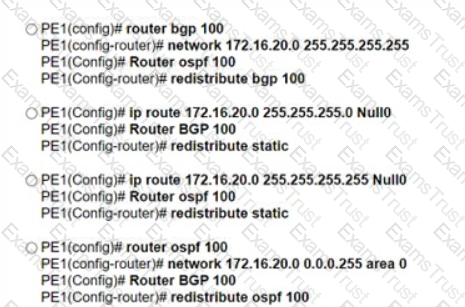
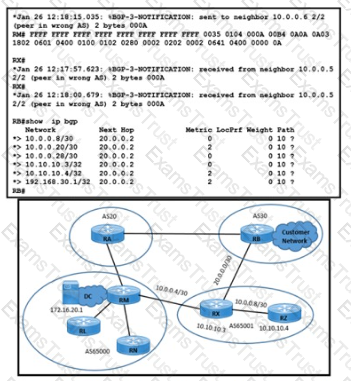
Refer to the exhibit. An engineer working for a private telecommunication company with an employee id: 4233:46:364 notices that the customer network going through AS30-AS65001-AS65000 is experiencing packet drops when it accesses an application at 172.16.20.1/32 In the DC cloud. The BGP link between AS20 and AS30 is inaccessible because of a fiber cut. Routers RL, RN, and RZ are configured with confederation identifier 10. Which action resolves this Issue?
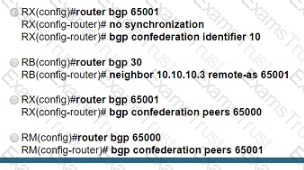
In a PIM-SM environment, which mechanism determines the traffic that a receiver receives?
The operator must leverage automated steering and coloring with the design. Which two elements from an SR Policy tuple are used for automated steering inside of the network? (Choose two.)
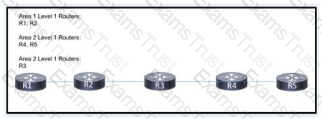
Refer to the exhibit. This network is deployed with all connected links configured to run IS-IS. The routing protocol is enacted globally on each router, and the network engineer expects full routing Information to be shared among all routers. R5 is receiving routes from R4 but is missing routes from R1. Which action corrects the issue so that all routes are shared among the routers?
Which difference should be considered when intradomain or interdomain multicast routing is implemented?
What is the role of a segment routing mapping server?
Which IPv6 prefix format defines the destination of a dynamic 6to4 tunnel?
Which command is used to enable BIDIR-PIM under global configuration mode for Cisco IOS XE Sofware?
Refer to the exhibit.
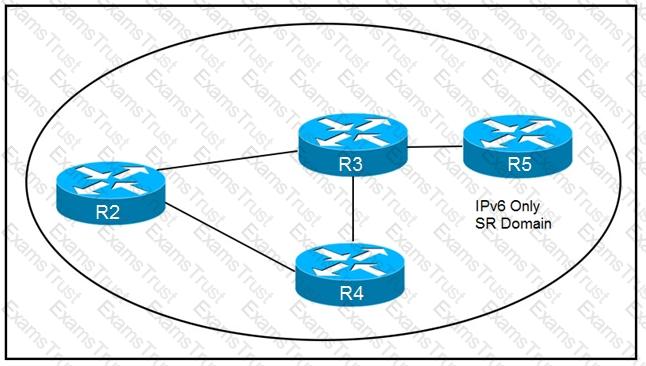
How are packets directed through the data plane when SRv6 is implemented?
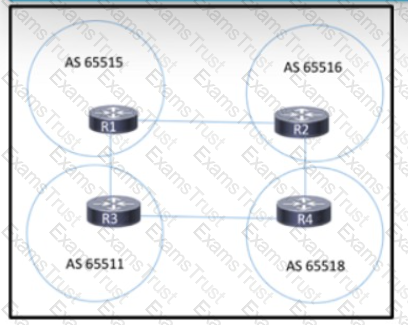
Refer to the exhibit. Routers R1. R2, R3. and R4 are peer routers that reside in different administrative domains. PIM-SM is running in each autonomous system, and EBGP is configured between the peers. A network administrator has just implemented MSDP between the connected peers. When the administrator enabled the MSDP configuration. R1 and R2 failed to establish a peering relationship. All other connected routers successfully established peering sessions Which action must the engineer take to resolve the issue between R1 and R2?

Refer to the exhibit. Router R1 is expected to receive routes that originate from AS 65547 only. However, R1 is receiving routes from AS 65547 and several other ASs that are directly attached to it. Which change to the AS path permit filter corrects the problem?
Refer to the exhibit.
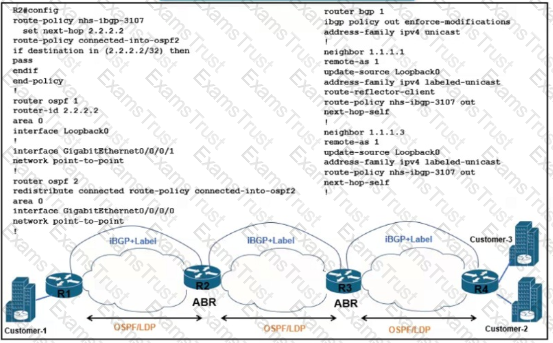
There is a connectivity issue between Customer-1 and Customer-2 File servers between the customers cannot send critical data R3 routes are missing from the routing table on the Customer-1 router All interlaces on Customer-1 are up Which configuration must be applied to router R2 to correct the problem?
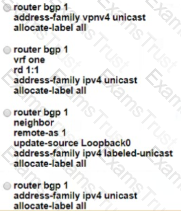
Refer to the exhibit.
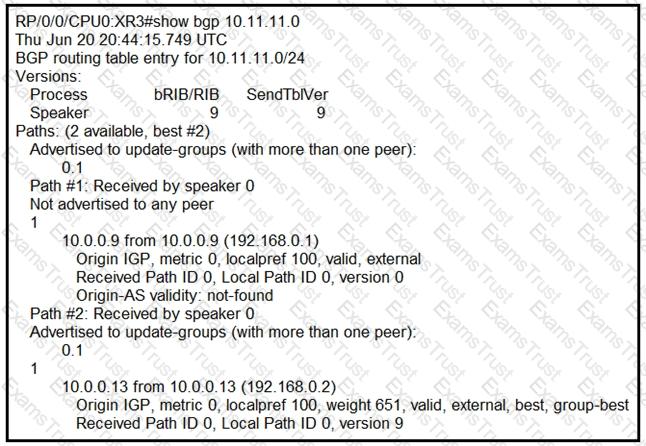
A network operator is getting the route for 10.11.11 0/24 from two upstream providers on
#XR3. The network operator must configure #XR3 to force the 10.11.11.0/24 prefix to route via next hop of 10.0.0.9 as primary when available. Which of these can the operator use the routing policy language for, to enforce this traffic forwarding path?
Refer to the exhibit.
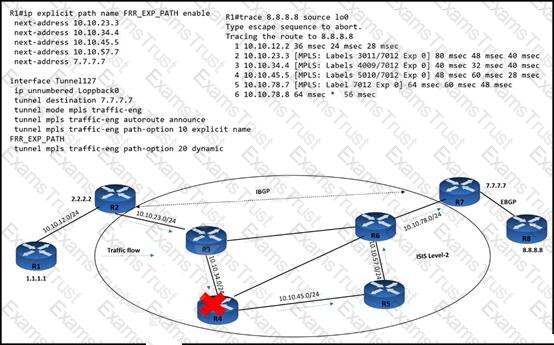
An MPLS core network has connectivity issues R4 has failed. It impacts traffic loss between R1 and R8. Customers report no access to their file servers, which delays their transformation work. Which quick action resolves the issue until R4 recovers?
After changing the IP address on an IOS XR router, an engineer cannot ping the new address Which step did the engineer forget to complete?
Refer to the exhibit.
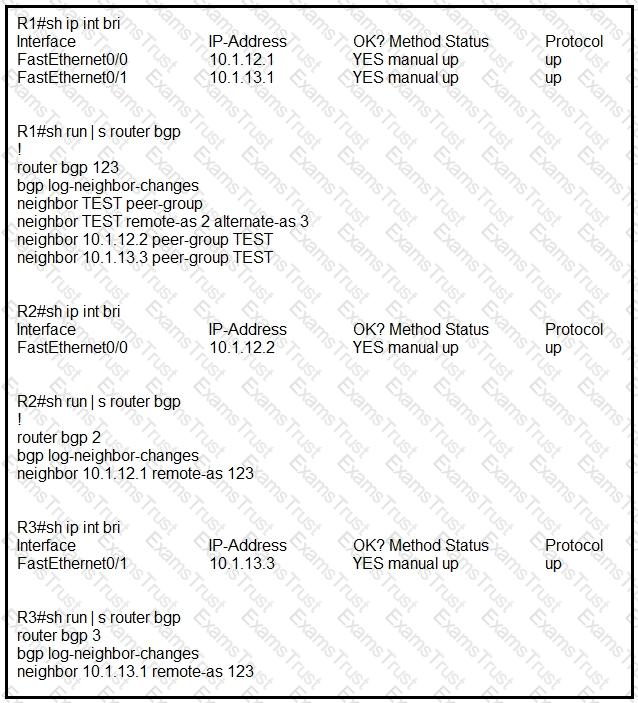
R1 is directly connected to R2 and R3. R1 is in BGP AS 123, R2 is in BGP AS 2, and R3
is in BGP AS 3. Assume that there is no connectivity issue between R1, R2 and R1, R3. Which result between
BGP peers R1, R2 and R1, R3 is true?
Refer to the exhibit.

Why is neighbor 10.1.5.5 stuck in “2WAY” state?
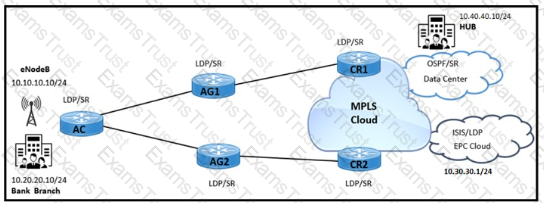
Refer to the exhibit. A service provider has LDP and segment routing running in the network. Mobility traffic is carried through LDP and enterprise traffic is carried through segment routing. Which configuration must be implemented to connect the bank branch with the HUB site on routers?
Which cost is the default when redistributing routes from BGP to OSPF?
What is the difference between RPL and route-maps?

Refer to the exhibit. The Cisco router has a single uplink to the upstream network, which is critical to the business. The router is configured for traffic steering with the Autoroute mechanism configured to steer all OSPF and IS-IS prefixes over non-shortest paths and divert traffic for those prefixes to the SR-TE policy. However, the Autoroute Announce functionality for all prefixes is not working. Which additional command set must the engineer configure on the router to correct this issue?
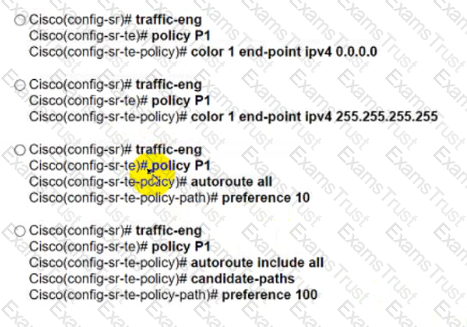
Refer to the exhibit.
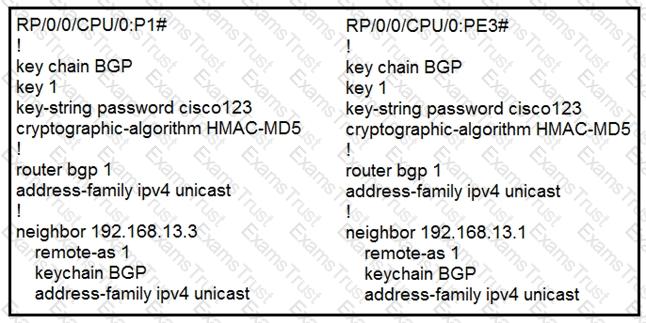
P1 and PE3 Cisco IOS XR routers are directly connected and have this configuration
applied. The BGP session is not coming up. Assume that there is no IP reachability problem and both routers
can open tcp port 179 to each other. Which action fixes the issue?
Refer to the exhibit.
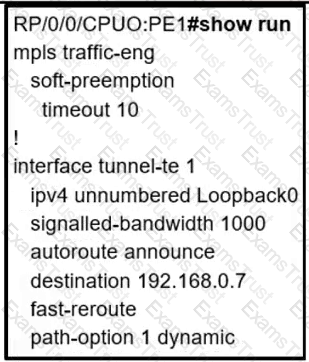
A network operator is troubleshooting TE tunnels and discovers that the soft preemption is not working as desired. Where should the soft preemption be applied to solve the issue?
Which feature is used in multicast routing to prevent loops?
What is the difference between RPL and route map actions?
Refer to the exhibit.
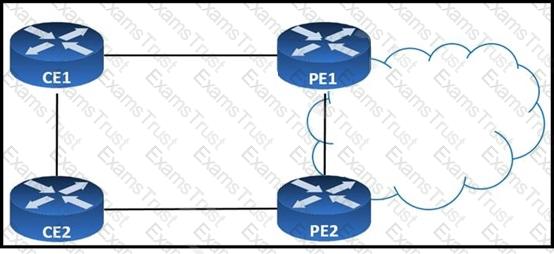
CE1 and CE2 are iBGP neighbors in AS 65516. All traffic that exits AS 65516 must use the link from CE1 to PE1. CE1 is advertising a higher local preference to CE2, but traffic from CE2 still prefers the PE2 link. Which action corrects the problem?
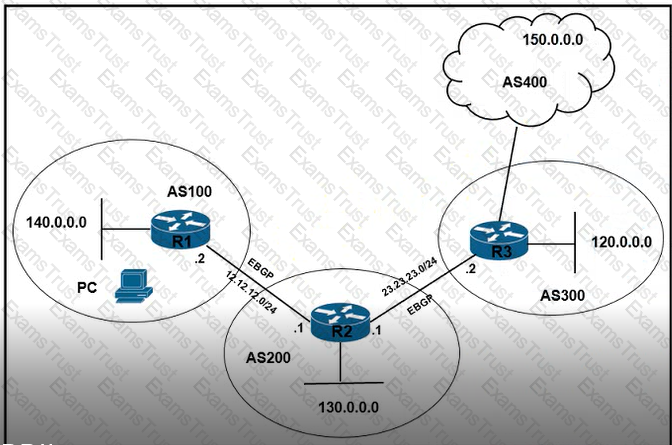
Refer to the exhibit. Excessive routes are flooding from network 150.0.0.0 into AS100. Internet traffic between AS400 and AS300 is working normally. No route controlling mechanism is applied on incoming and outgoing traffic Which configuration resolves the issue?
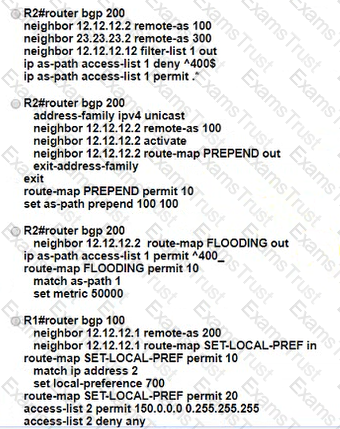
Refer to the exhibit.
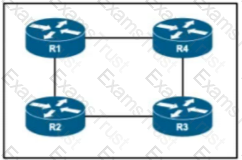
All routers on this network have been configured with P1M-SM and R1 is the rendezvous point However, when asymmetric routing is implemented to modify link usage the network begins to drop certain multicast traffic Which action corrects the problem?
Refer to the exhibit.

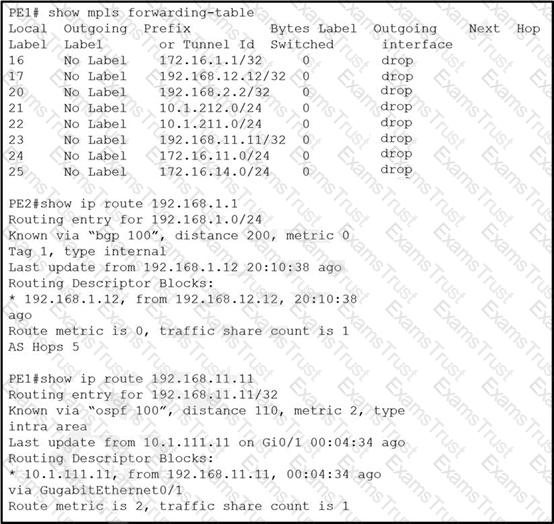
VPN users that are connected to PE routers are facing network issues. Traffic that originates from CE1 drops before reaching CE2. An engineer finds no outgoing traffic statistics on PE1 and PE2 routers toward CE devices and finds that the PE1 router is running the older software image. Which action must be implemented to resolve the issues?
A network engineer is troubleshooting OSPF multiarea. Which Cisco IOS XR feature should the engineer use in order to streamline OSPF issue?
Which feature provides service independence in service provider networks?
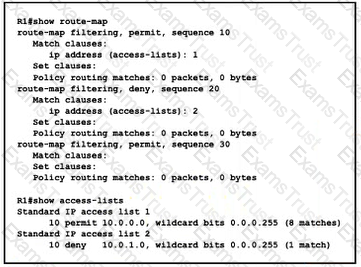
Refer to the exhibit A network engineer configured the redistribute connected subnets route-map filtering command on R1 to redistribute connected interfaces to the OSPF process The engineer also wants to filter out IP address 10 0 1 0/24. but the prefix still appears in the routing tables of the other routers on the network. Which action corrects the problem?
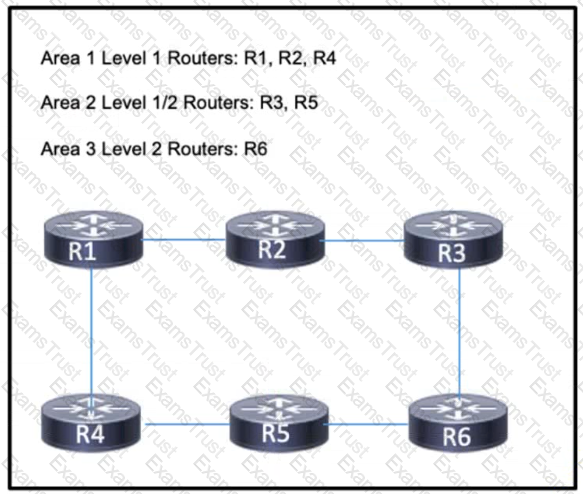
Refer to the exhibit. An engineering team implemented IS-IS on the network, with several different areas. Recently, router R6 in area 3 has been experiencing excessive CPU usage. To reduce the load, a network engineer implemented route summarization on R2 However. R6 is still receiving the full routes from all routers. Which action must the engineer take to resolve the excessive CPU usage?
While configuring Cisco NSF awareness, a network engineer enters the bgp graceful-restart command after the BGP session is established in a router that runs IOS XE Software. Graceful restart capabilities are not exchanged. Which two actions should be taken? (Choose two.)
Which lag command is used within route-map to redistribute routes that match with routes tagged with the specified tag numbers?
For which reason can two BGP peers fail to establish a neighbor relationship?
Refer to the exhibit.
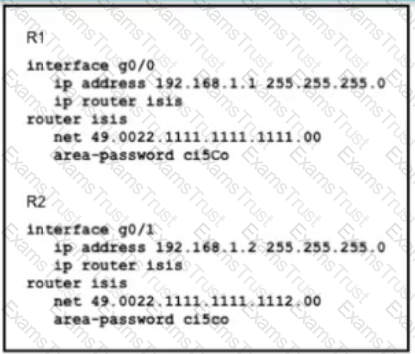
After these configurations were applied to routers R1 and R2. the two devices cannot form a neighbor relationship What is the reason tor the problem?

Refer to the exhibit After recent configuration changes to a customer's network, a network engineer notices that R2 cannot communicate with R3 Both FastEthemet interfaces on R2 and R3 are up and configured with the correct IP addresses MD5 password configured en R2 and R3 match with no issues What is the minimum change the engineer must make to enable R2 and R3 to communicate and fix the problem?
Refer to the exhibit.

What is the relationship between Router 1 and Router 2?
After an engineer configures BGP in R1, it starts receiving this message
*Jun 29 13:30:50.122: %BGP-5-ADJCHANGE: neighbor 192.168.10.1 Down User reset
Jun 29 13:30:52.341: %BGP-3-NOTIFICATION: sent to neighbor 192.168.10.1 2/6 (unacceptable hold time) 0 bytes
Which action makes the peering come back up again?

Refer to the exhibit. Company A established BGP sessions with several ISPs. A network engineer at the company must filter out all traffic except for routes that transit AS 152. The engineer configured the filtering policy “permit _152S_(_[0.9])” on R1, but after applying the configuration, the engineer notices that other routes are still visible. Which action resolves the issue?
